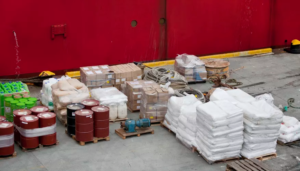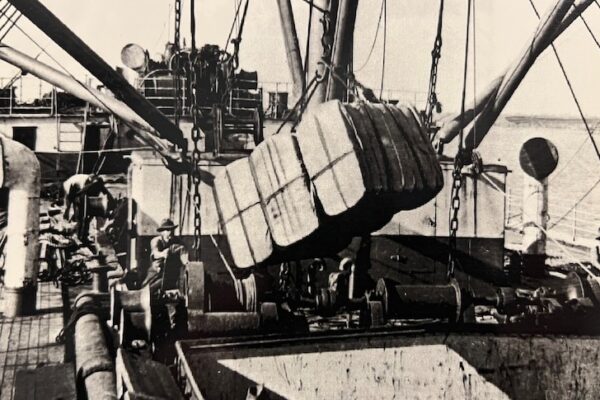Image above: Queensland cotton being loaded into the hold of the SS Westmorland in 1921. (Credit: Cotton Australia).
There are two major forms of shipping cargo: break-bulk and containerisation. Roughly 90% of all goods worldwide are shipped by sea and 70% of that is containerised cargo. However, as we have reported over the past year or so, a number of factors have combined to result in a global shortage of containers. This has caused Australian exporters to seek alternatives.
Like other businesses, Australia’s cotton industry has had to face the challenge of disruptions to global shipping container flows. As with most of the world’s goods that are exported by sea, cotton normally gets loaded inside shipping containers. Now that is about to change, with more than 100,000 bales being exported from Brisbane to Turkey via break bulk shipping.
The company doing this shipment is utilising a hospital-grade ship, which has been used in the past for wood pulp. It is a vessel with a gantry-type crane system on it that can lift the cotton bales off the dock and into the hold in an efficient way and a way that doesn’t damage the cotton.
The term Break-bulk Shipping covers items that are not packed into containers, but are not loose material, such as liquid bulk, coal or grain. With their own packaging, such as crates, cartons, bags or drums, they get loaded into cargo holds. This method is normally chosen when it is more suitable for the type of product in the consignment, but sometimes the port of destination needs to be taken into consideration too. Break-bulk comes in handy for ports that aren’t capable of handling containers, either because they are not equipped with the cranes required to hoist the containers, or because they are not deep enough to accommodate the larger container vessels.

A couple of years ago, China was buying about 70% of Australia’s cotton crop. Then in October 2020, the Chinese government started to tell mills to stop buying Australian cotton or risk their quotas being slashed.
This reduction in product sent to China has restricted the number of empty containers available to move cotton to Australia’s biggest markets, Vietnam and Indonesia. The irony is that a significant number of 40-foot containers leaving Australia are now shipped back to China empty.
The difficulty in situating empty shipping containers when and where they are needed, is what is behind the cotton industry going back to the exporting methods they used in by-gone days – with what they have referred to as an “innovative” break bulk shipment being loaded at the Port of Brisbane. Instead of packing cotton into 40-foot containers, the consignment has been loaded as break bulk into the hold – the procedure commonly used to export bales prior to containers becoming widely available in the 1970s.
The industry has been working hard to find new markets and expand existing ones, such as Turkey, where the shipment in question is bound for. Turkey is now taking around 8 to 10% of Australia’s export.
[The image at the top of the page is of Australia’s first shipment of ginned cotton, which occurred more than 100 years ago. The bales from Queensland were loaded onto the SS Westmorland, bound for England in July 1921.]
For information on shipping schedules, freight rates and container availability, talk to us here at Colless Young. As licensed Customs Brokers and International Freight Forwarders, we offer correct, professional advice on all your import and export cargo shipping needs. We provide a complete range of logistics services, for both air and sea freight, including fumigation, warehousing and trucking – through all Australian ports and airports.

